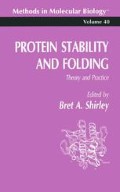Abstract
The intent of this chapter is to provide realistic procedures for identifying sites of posttranslational modifications in proteins. Particular emphasis will be directed toward identifying degradative covalent changes, such as deamidation and oxidation, that are thought to be associated with protein “aging” and to influence protein stability. The first issue that arises is how one goes about detecting the more than 100 different posttranslational modifications that have already been identified in proteins (1, 2). In light of this diversity, those techniques are most useful that can detect any, or at least most, possible modifications. Although a technique like isoelectric focusing can detect modifications, such as phosphorylation and deamidation, that result in altering the net charge, this technique would be less likely to detect sulfoxide formation. The two techniques that come closest to being able to rapidly detect most possible modifications are comparative HPLC peptide mapping and mass spectrometry, which can be used to determine accurate masses on both the intact protein and its HPLC-separated peptides. Since electrospray mass spectrometry (ESMS) can routinely determine the mass of a 50 kDa protein within 0.01% (3), any modification that altered the mass of this protein by more than ±5 atomic mass units (amu) could be detected. Hence, assuming that the mass of the nonmodified protein is known, ESMS of the intact protein should succeed in rapidly detecting phosphorylation (+80) and oxidation (+16), but would, for instance, fail to detect deamidation (+1).
Access this chapter
Tax calculation will be finalised at checkout
Purchases are for personal use only
References
Krishna, R. G. and Wold, F. (1993) in Methods in Protein Sequence Analysis (Imahori, K. and Sakiyama, F., eds.), Plenum, New York, pp. 167–171.
Harris, R. (1993) ABRF News 4(3), 8–10.
Williams, K. R. and Carr, S. A. (1995) in Encyclopedia of Molecular Biology and Biotechnology (Meyers, R. A., ed.), VCH, New York, in press.
Kawasaki, H., Emori, Y., and Suzuki, K. (1990) Anal. Biochem. 191, 332–336.
Stone, K. L. and Williams, K. R. (1993) in A Practical Guide to Protein and Peptide Purification for Microsequencing, 2nd ed. (Matsudaira, P. T., ed.), Academic, New York, pp. 43–69.
Rosenfeld, J., Capdevielle, J., Guillemot, J., and Ferrara, P. (1992) Anal. Biochem. 203, 173–179.
Aebersold, R. H., Leavitt, J., Saavedra, R. A., Hood, L. E., and Kent, S B. (1987) Proc. Natl. Acad. Sci. USA 84, 6970–6974.
Fernandez, J., DeMott, M., Atherton, D, and Mische, S M. (1992) Anal Biochem. 201, 255–264.
Stone, K. L., McNulty, D. E., LoPresti, M. B., Crawford, J. M., DeAngelis, R., and Williams, K. R. (1992) in Techniques in Protein Chemistry III (Angeletti, R., ed.), Academic, New York, pp. 23–34.
Laemmli, U. K. (1970) Nature 227, 680.
Stone, K. L., Elliott, J. I., Peterson, G., McMurray, W., and Williams, K. R. (1990) in Methods in Enzymology (McCloskey, J., ed.), Academic, New York, pp. 389–412.
Stone, K. L., LoPresti, M. B., and Williams, K. R. (1990) in Laboratory Methodology in Biochemistry: Amino Acid Analysis and Protein Sequencing (Fini, C, Floridi, A., Finelli, V. N., and Wittman-Liebold, B., eds.), CRC, Boca Raton, FL, pp. 181–205.
Sun, Y., Zhou, Z, and Smith, D. (1989) in Techniques in Protein Chemistry (Hugli, T., ed.), Academic, New York, pp. 176–185.
(1991) in High Performance Liquid Chromatography of Peptides and Proteins. Separation, Analysis and Conformation (Mant, C. T. and Hodges, R. S., eds.), CRC, Boca Raton, FL.
Stone, K. L., LoPresti, M. B., Crawford, J. M., DeAngelis, R, and Williams, K. R. (1991) in High Performance Liquid Chromatography of Peptides and Proteins: Separation, Analysis and Conformation (Mant, C. T. and Hodges, R. S., eds.), CRC, Boca Raton, FL, pp. 669–677.
Glocker, M. O., Arbogast, B, Schreurs, J., and Deinzer, M. L. (1993) Biochemistry 32, 482–488.
Author information
Authors and Affiliations
Editor information
Editors and Affiliations
Rights and permissions
Copyright information
© 1995 Humana Press Inc.
About this protocol
Cite this protocol
Williams, K.R., Stone, K.L. (1995). Identifying Sites of Posttranslational Modifications in Proteins Via HPLC Peptide Mapping. In: Shirley, B.A. (eds) Protein Stability and Folding. Methods in Molecular Biology™, vol 40. Humana Press. https://doi.org/10.1385/0-89603-301-5:157
Download citation
DOI: https://doi.org/10.1385/0-89603-301-5:157
Publisher Name: Humana Press
Print ISBN: 978-0-89603-301-6
Online ISBN: 978-1-59259-527-3
eBook Packages: Springer Protocols

